The Truth About Human Species
David Noel
<davidn@aoi.com.au>
Ben Franklin Centre for Theoretical Research
PO Box 27, Subiaco, WA 6008, Australia.
* * * * * * * * *
What Scientists Tell Us
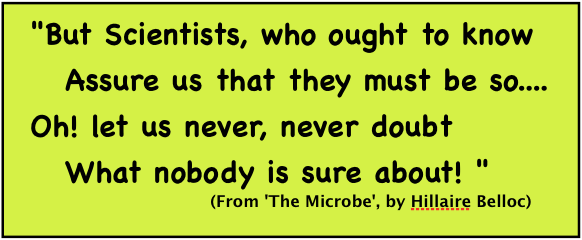
Quotation TAHQ-1
About Humans
It is very understandable that people are intensely interested in the species and race of which we all form part. According to the poet Alexander Pope, writing in 1734, "The proper study of Mankind is Man".
Here are just some of the questions asked about Mankind and his origins.
Q1. Did modern man evolve in Africa, and spread from there into all regions of the Earth?
Q2. Did the cleverer humans from Africa wipe out or outbreed the Neanderthals who occupied Europe?
Q3. Will 'Missing Link' fossils, showing how modern man evolved from earlier species such as Homo erectus, ever be found?
Q4. From whom did the third human species, the Homo floresiensis "Hobbit Man" who lived in South-East Asia till some 18,000 years ago, descend?
Q5. How many species of humans have ever existed?
Q6. Are humans with bigger brains cleverer than those with small?
Q7. Are some races of Man inherently more intelligent than others?
In this article, we'll answer all these questions, sometimes in a surprising way. Certainly, with newly-effective DNA genome studies of ancient human remains, and with discoveries of human remains at some new and unexpected sites, we have available more and more evidence.
Looking at the Big Picture
An active field of study, such as the sciences, can be compared to a tree. At any given time, each of the various branches of science, such as physics, botany, astronomy, or geology, will show varying activity, various degrees of popular interest.
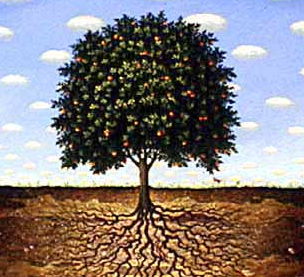
Figure TAH1. The Tree of Science. From [1].
What the public and most of the scientific community see is what happens at the branches. At some spots vivid new fruits appear, or strings of little lamps light up, maybe a gorgeous new fairy shows up at the top. This is all the interesting new results and data coming out.
But all this new and exciting work ultimately rests on what exists at the root of the tree, on the basic assumptions which underlie everything else. Surprisingly, much of established modern science is riddled with rank fallacies, or plausible but wrong assumptions. Some of these are noted in Great Fallacies of Science and Society [2].
Do these misbeliefs matter in most work? Often they do not. Much of the detail of the new results is not affected by resting on a wrong assumption. But ultimately, at the cutting edge, an underlying fallacy may distort the emergence of new truths and stultify the development of a branch of science.
Take one example. For more than 60 years, we have been told that the Universe came into being in an extremely compressed state, almost 14 billion years ago. Since then, it has greatly expanded to its present density, and it continues to expand. The Big Bang Theory.
Just a little knowledge of the stars and galaxies out there, plus a minimum of logic, shows that this whole idea is kaput. If the Expanding Universe idea was correct, then looking back into the earlier Universe, which we can do because light now reaching us travelled from these earlier times, more compressed patterns of galaxies should be seen.
For example, if we see the Universe as it was 7 billion years, when it would be roughly half expanded compared to now, the galaxies from that time should appear twice as close together. They do not. At every stage of the Universe, old or new, the density of galaxies is similar to that seen now around our modern Earth.
So it's pointing out the obvious to say that the Big Bang idea is untrue. But you don't get a Nobel Prize for pointing out the obvious, even though it wasn't obvious before you pointed it out.
![You don't get a Nobel Prize for pointing out the obvious, even though it wasn't obvious before you pointed it out. [3]](NobelText.png)
Quotation TAHQ-2
Of course there is also a mass of scientific evidence which leads necessarily to the same conclusion [4], but that's not the point. The Big Bang Theory fails the simplest of tests. Unless the entrenched establishment can explain this test failure, it is purposeless to even bother to listen to them.
Returning now to the topic of Human Species, we will come up with a similar obvious error in earlier reasoning. We may need to work up to this gradually, though.
The Ancestor Paradox
The Ancestor Paradox consists in the following. If the norm is to have 2 parents, 4 grandparents, 8 grandparents, and so on, then the number of your ancestors at a given number of generations back will be quite large.
Assuming three generations each hundred years, 100 years ago you had 2^3 (2 to the power 3 = 8) ancestors. Each earlier 100 years increases the number by 2^3, so one thousand years ago, 1000 AD or around then, you had 2^30, or about 5,000,000,000 (five billion) ancestors. But the population of the world in 1000 AD was only 250-350 million people [6]. How can this be?
The answer to the paradox is, that many of your ancestors will be ancestors on more than one line. The nearer to the present you have ancestors on more than one line, the fewer ancestors you need -- if two first-cousins marry, their children immediately lose one-quarter of their ancestors [5].

Figure TAH2. Loss of Ancestors Caused by a First Cousin Marriage. From [5].
When parents are closely related, this is called inbreeding. But you don't need inbreeding to cut down the number of your ancestors. There is an example of this in my own family.
I had the usual 2 parents (Bill and Kitty), 4 grandparents, 8 great-grandparents, and 16 great-great-grandparents. My mother's siblings included Nora, who married Bert and whose children included my cousin Tony, also Phyllis, who married Freddie and whose children included my cousin Colin.
It so happened that Bert and Freddie were themselves cousins, cousins marrying two sisters. There is no instance of inbreeding here. But because cousins have a grandparent or two in common -- that is one definition of a cousin -- my cousins Tony and Colin have only 14 great-great-grandparents instead of the usual 16.
Who Do You Think You Are?
Each episode of the television series "Who Do You Think You Are?" traces back the genealogical history of a notable person. In the episode on the British comedian Alexander Armstrong [7], he is surprised and chuffed to find out that he is descended from William The Conqueror.
If there is one date in history which most Britons can remember, it is 1066 AD, the year that the Norman king William and his army invaded Britain, and defeated English king Harold, shot with an arrow through his eye. So Alexander Armstrong could very justifiably be pleased with his place on the distinguished family tree of England's monarchs.
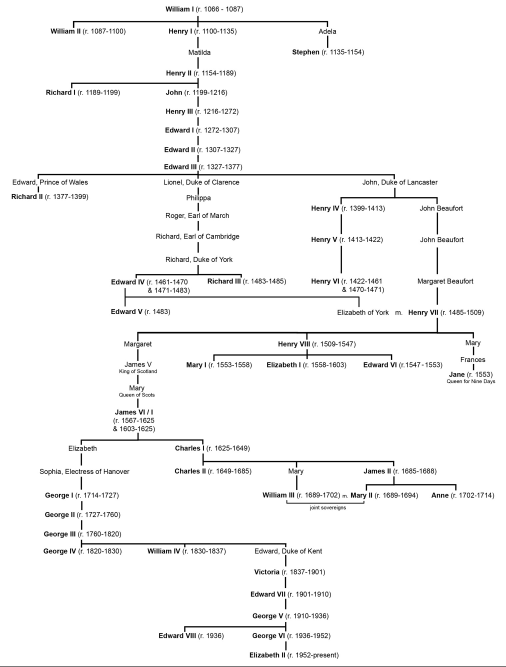
Figure TAH3. England's royalty. From [8].
So Alexander's great-(x27)-grandfather was William The Conqueror, and he can have a family tree on the wall similar to that of the royal family. No argument with this picture, but from the human descent viewpoint, what's left out?
Well, since the gap between William and Alexander is about 30 generations, and about 1000 years, almost everything in the picture is selected out at one end or the other. Assuming William's descendants averaged out at 2 children per family, he could have 5 billion descendants at the present time. And Alexander could have as many as 5 billion ancestors at William's time.
Of course, in practice the number of your ancestors or descendants 1000 years away will be very much less than 5 billion, because these sets will include many individuals who figure on your family tree on more than one line, sometimes on many lines. One of the big factors in this is proximity -- obviously people will tend to mate with people who live nearby.
Other factors will favour ancestor/descendant spread. Close in-breeding, incest, is generally frowned upon, many tribal peoples want their men to marry a girl from a different tribe. Marauding Vikings, on missions of pillage and rape, will insert their own rather foreign genes into the victims. Even modern migration, where a man goes ahead to establish a foothold in a new country, may have this effect. And even for the individual in a settled society, a person of the opposite sex who has 'exotic' characteristics (say, red or blonde hair in a generally dark-haired society) will often be especially desired in marriage.
Using British church and birth records, it may be possible to estimate the Ancestor Spread Factor (ASF) for real cases, going back close to 1000 years. Detailed individual genome analyses, like those done by 23andme.com, may also possibly be used.
But even without such estimates, it might be expected that the ASF at 1000 years could be in the low thousands. This is a big reduction from the theoretical 5 billion, and could be an underestimate. Nevertheless, it is clear that over 1000 years, the multiplication factor for your ancestors or descendants is far, far, greater that usually implied by family trees.
And note, go back another 1000 years, and the this factor does not double, it squares, to millions. Go back even further, and the value is constrained by the total number of people in the world at that time.
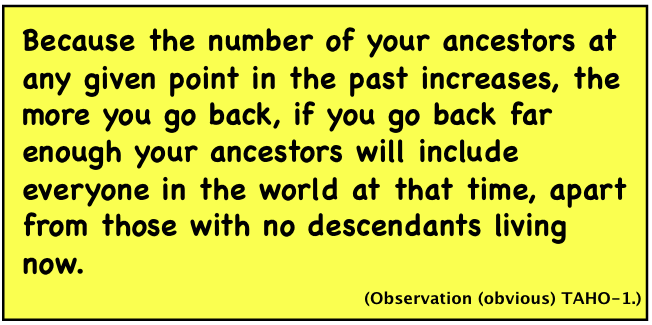
Observation (obvious) TAHO-1.
Why theoretical descendant numbers shrink
We have identified some of the reasons why the number of your ancestors is much smaller than that theoretically possible. Now we look at why a given individual's descendants average out at much less than theory allows.
Many lines of descent terminate before reaching the present -- someone is noted as "deceased without children". Instead of a nice slim family tree like that in Fig. TAH3, the lives of a given separate population, such as all members of the genus "Homo", can be thought of as fibres in a piece of thick rope.

Figure TAH4. Intertwined family trees as a piece of rope. From [12].
The cross-sections of this 'rope' at a point in the past and at the present time will be extremely complex. The following figure shows a CT scan across a polymer climbing rope. In the general population 'rope' there will be untold millions of individual short fibres, each representing a parent-child link.
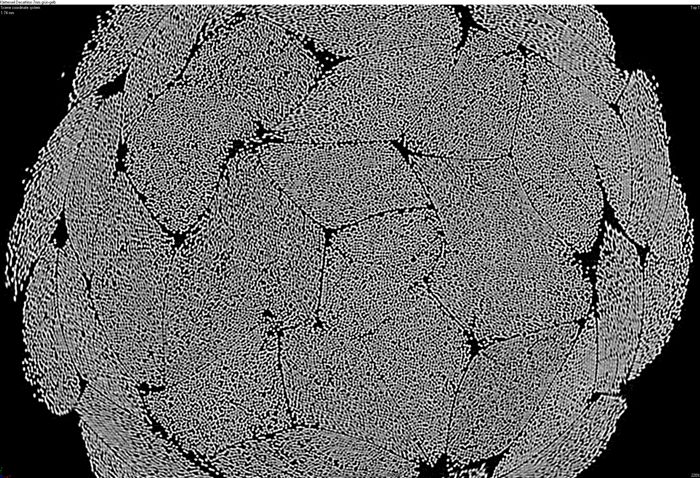
Figure TAH5. Cross-section across a piece of climbing rope. From [13].
For a separate complete population, such as all the people in the world, whether the rope swells out or shrinks with time depends on how the population is thriving. If births more or less balance out deaths, the 'rope' will keep the same thickness.
But back into recorded history, and further back to when civilization developed with humans, births have hugely exceeded deaths. The bottom end of the population 'rope' is hugely widened -- more than 7 billion parent-child fibres reach down to the rope cross-section of the present day.
How many early humans were there?
While the Wikipedia article on Human Evolution [10] gives a lot of information on early humans, it has no estimates on how many of these existed at any time. It's not until as late as 8000 BC that a quotable figure is given -- 5 million people. Here's an extract from How Many People Have Ever Lived on Earth? [11].
"Fixing a time when the human race actually came into existence is not a straightforward matter. Various ancestors of Homo sapiens seem to have appeared at least as early as 700,000 B.C. Hominids walked the Earth as early as several million years ago. According to the United Nations Determinants and Consequences of Population Trends, modern Homo sapiens may have appeared about 50,000 B.C. This long period of 50,000 years holds the key to the question of how many people have ever been born.
At the dawn of agriculture, about 8000 B.C., the population of the world was somewhere on the order of 5 million. (Very rough figures are given in the table; these are averages of an estimate of ranges given by the United Nations and other sources.) The slow growth of population over the 8,000-year period, from an estimated 5 million to 300 million in 1 A.D., results in a very low growth rate—only 0.0512 percent per year. It is difficult to come up with an average world population size over this period. In all likelihood, human populations in different regions grew or declined in response to famines, the vagaries of animal herds, hostilities, and changing weather and climatic conditions."
Looking at our ancestor groups
While no-one is really sure about the details, we have some reasonable reconstructions of how present and past groups of humans may have been related. Here is one example.
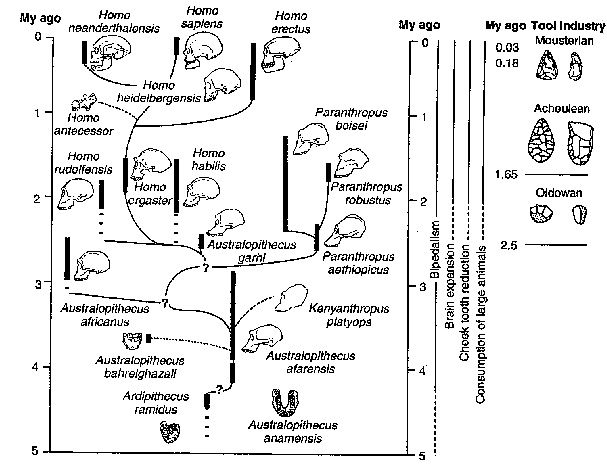
Figure TAH6. One view of evolution of humanity. From [9].
In this picture, the oldest groups are at the bottom, dated to about 5 million years ago. The present time is at the top, with 'My' (million years) ago = 0. Four human groups are placed within the last million years, Homo neanderthalensis, Homo sapiens, Homo erectus, and Homo heidelbergensis. Other researchers may have different groups and links.
In these names, the first part, written with a capital letter (eg 'Homo') is the name of the genus (plural=genera), and all groups with the same genus name will be related. The second part (eg 'sapiens') is the name of the species within the genus. Here we will want to know all about what 'species' means, especially as applied to humans.
Hearts Of Oak -- all about species
The English Oak holds a special place in the hearts of Britons. A symbol of toughness, usefulness, and longevity, this native oak once covered big areas of Britain. Most of Britain's oak trees were felled over the last 500 years, especially to build ships to fight in naval battles.
The genus name for oaks is Quercus, the species name for the English Oak is robur, so the botanical name, usually written in italics, is Quercus robur. It is the only oak species native to Britain, but other species are found throughout the temperate and subtropical areas of the northern hemisphere.
According to Mabberley's The Plant-Book, the ultimate reference manual for plantsmen [15], there are about 400 species of Quercus, with two Centres of Diversification (areas with many species), in Mexico and in the eastern Himalayas.
Botanists and taxonomists (classifiers) tell the species apart by their different types of leaf or bark, growth habit, and native location. They are always arguing as to whether two specimens are two separate species, or only two forms of the same species.
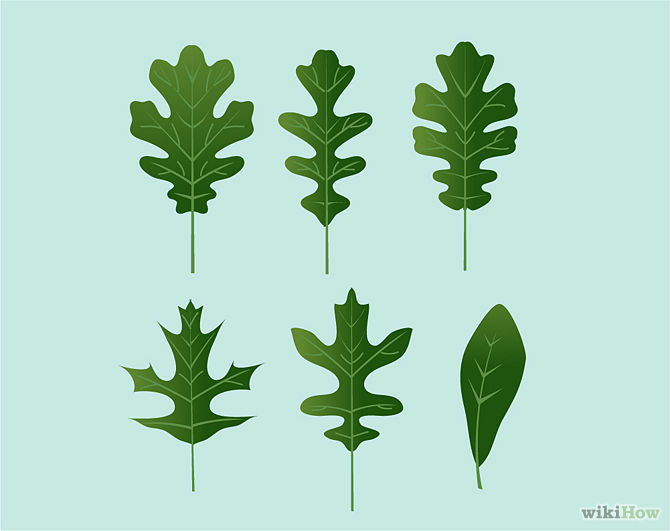
Figure TAH7. Some oak leaf shapes. From [14].
We need to get a more accurate idea of what 'species' means, whether for oaks, human groups, or other forms of life. Here's an extract from what Wikipedia [16] says.
In biology, a species (plural: species) is one of the basic units of biological classification and a taxonomic rank. A species is often defined as a group of organisms capable of interbreeding and producing fertile offspring. While in many cases this definition is adequate, the difficulty of defining species is known as the species problem. Differing measures are often used, such as similarity of DNA, morphology, or ecological niche.
Species hypothesized to have the same ancestors are placed in one genus, based on similarities. The similarity of species is judged based on comparison of physical attributes, especially their DNA sequences, where available. All species are given a two-part name, a "binomial name".
So basically, if two specimens are judged capable of interbreeding, and have the same ancestors, they fall in the same species. It seems simple enough, but when you go into it, many difficulties emerge -- "The Species Problem".
Back to the Oaks. Oaks produce separate male and female flowering structures, the male structures are usually 'catkins', long ropes giving off pollen, while the female structures receiving pollen are small and not very obvious. Because pollen can be easily harvested from oaks in one area, and applied to the female parts of a quite different species, perhaps one growing a long way away, it is easy to try to 'cross' different species of oaks.
Problem 1. Almost all such 'crossing' attempts in oaks work perfectly well, producing viable plants with a mixture of their parents' characteristics. So, according to the definition of species, all oaks fall into a single species -- Quercus comprehensive.
The logic is clear, but the consequences are annoying. If you are a cork producer and order a batch of seedlings of the Cork Oak, Quercus suber, it will be completely unsatisfactory if the supplier gives you seedlings of a different Quercus species which does not produce cork. So here, logic must give way to commonsense. The old species names stay.
Ring Me A Salamander
Sometimes a species exists over quite a large linear range, maybe 10,000 km or more. Because the range includes a variety of physical conditions, the local stock adapts to the local conditions -- its DNA set gets selected to suit. This variation of a species over a wide range is called a 'clade'.
Problem 2. Sometimes, for a large clade, variation in the species characteristics from one end to the other is great enough that specimens from the two ends cannot breed. This would mean the end-specimens should therefore be regarded as separate species. But, everywhere along the clade, any specimen can breed with its neighbours on both sides, so all variations fall into the same species.
Dennis McCarthy [19] describes a fascinating example of a clade which is twisted round on itself to form a ring. The clade is of a sometimes colourful salamander called Ensatina [20], existing along the western coast of America. Salamanders are essentially amphibians like newts, though sometimes they omit the aquatic phase in their life-cycle, and Ensatina has no lungs, but breathes through its pores.
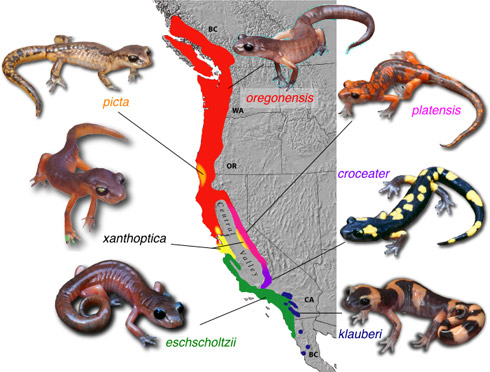
Figure TAH8. Variation in Ensatina salamanders along a ring clade. From [21].
The figure shows how these salamanders differ from each other in different areas around California's Central Valley. The variations are grouped into 'sub-species', parts of a species with noticeable variations between these parts, but without the implication that they are separate species.
Sub-species oregonensis exists in the north of Ensatina's range, from British Columbia down into California. The Central Valley itself is inhospitable to salamanders, but on its eastern rim, oregonensis changes first to the orange-marked platensis, and then to the yellow-spotted croceater.
On the western rim, the sub-species changes first to xanthoptica, and then to the browny-orange eschscholtzii. At the south end of the Central Valley, croceater and eschscholtzii come into contact. These two sub-species, with wildly different colouring and marking, do not interbreed, even though they lie within a single species.
The formal way of denoting a subspecies within a species is to repeat the species name plus a third element denoting the subspecies, as in Ensatina eschscholtzii picta.
Going To The Dogs
Clearly two members of a species cannot interbreed if they are very widely separated in space. One reason why all Quercus plants can interbreed, even though widely separated, is possibly that they are wind-pollinated, with their pollen blown over great distances, and so interchange of DNA with distant relatives can be usual.
Problem 3. Another reason why two members of a species cannot interbreed is because of physical limitations. Over the last few hundred years, people have produced breeds of dogs of widely varying sizes (see Fig. TAH9). Dogs at the extreme ends of the size range are physically unsuited to breed naturally, and even artificial insemination is likely to produce fertilization, or if it does, the resulting embryos are likely to be automatically rejected during foetal growth.
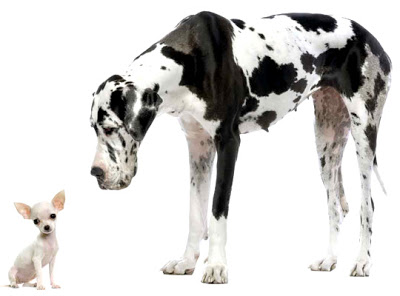
Figure TAH9. Extreme variation in dog size. From [22].
Domestic dogs are clearly all members of the same species, but if a scientist from outer space came across a situation where all dogs were either chihuahuas or irish wolfhounds, he would undoubtedly reckon they were two separate species.
Hello Dolly
In 2002, the accepted opinion was that modern man, Homo sapiens, came out of Africa some 40,000 or 50,000 years ago, and was advanced enough to be able to wipe out the dominant European species, Homo neanderthalensis. In that year, I put up on the Web an article How The Neanderthals Become The Basques [25], which gave evidence suggesting all previous humans had interbred to produce modern humanity. Here's what it said.
To round out the present scenario, it is suggested that the present world population is a complex hybrid mixture of at least two human species, one classed as Homo neanderthalensis, the other (or others -- if the A and B blood factors originated from separate species) as Homo sapiens. The genes from these species are now so intermixed (as in cultivated roses) as to make the species name indeterminate.
It's pointed out there that most modern roses are selections from a mixture of conventional species, so a species name can't be assigned. It's interesting that some rose growers raise plants which don't have this mixed heritage, they call them 'species roses'.
So a particular variety of rose, such as Dolly Parton, will have a formal botanical name of Rosa 'Dolly Parton'. The components of this are the genus, Rosa, followed by the variety or clone in single quotes. 'Clone' means that all individuals within the clone are genetically identical.

Figure TAH10. The Dolly Parton rose. From [24].
As an aside, there is an additional complication, involving the rootstock. In Perth, Australia, most roses are grafted on a special rootstock, Rosa fortuniana, which is a true species, discovered in China [23]. This is done because roses on Fortuniana rootstock grow well in the local sandy soils.
Returning now to the matter of human species, the suggestion above that all humans are within the genus Homo, without distinction of species, has become generally accepted. Nowadays, a genetic analysis company such as 23andme.com will analyze an individual's DNA and use its components to derive the origin of the individual's ancestors.
I've had this done myself. The results said that I had 4% Neanderthal DNA, and that I was at the 96% percentile (only 4% of people in the world had more Neanderthal DNA than me).
About Landraces
There is yet another way of splitting up the population within a species or genus, called the 'landrace'. Some landraces arise naturally as a plant or animal is taken to a new area with different environmental conditions, others are the result of intentional breeding. Here's some of what Wikipedia says [26].
A landrace is a local variety of a domesticated animal or plant species which has developed over time, by adaptation to the natural and cultural environment in which it lives. Landraces are usually more genetically and physically diverse than formal breeds.
Many formal breeds originated from attempts to make landraces more consistent through selective breeding, and sometimes a particular type has both landrace and formal breed populations. Sometimes a formalised breed retains a landrace name, despite no longer being a true landrace.
When an animal landrace is codified as a pedigree breed without significant selective breeding to alter it, though often to lock in its defining traits, it is often referred to as a natural breed or traditional breed by breeder and fancier organisations. Similarly, the term traditional variety is sometimes applied to plant landraces, and heirloom plants may be samples of landraces.
So a landrace is a subdivision within a species of a group of similar individuals, very alike but not genetically identical (clones). The word 'variety' is applied to both landraces and to clones, confusingly enough.
There is no universally accepted notation for a landrace. Here, the landrace name will be written with a capital letter within double quotes, as in Canis "Dalmatian" or Zea "Golden Cross Bantam" (a sweet-corn variety).
It will be apparent by now that all the species of Man are really only landraces, conveniently written Homo "Sapiens", Homo "Neanderthalensis", and so on. They are selections from the whole Homo population based on their location and some obvious physical characteristics. Let's look now at other ways of selecting groups from the human population, based on less obvious characteristics. But first, we'll formulate an observation.
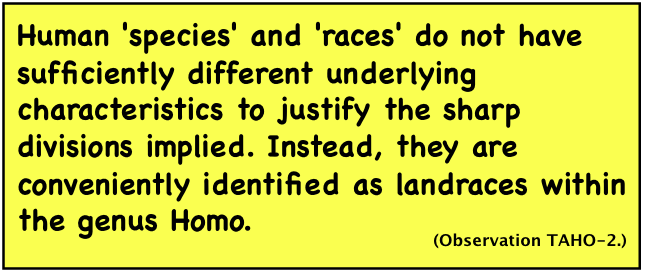
Observation TAHO-2. Landraces.
Blood Groups
We can work out quite a lot about different human landraces from blood groups. The main blood groups are A, B, AB, and O (more detail on this at [25, 27]). 'A' and 'B' are individual factors which may appear in someone's blood, if 'AB', both are present. Group 'O' means neither is present.
Following are some world distribution maps for different blood types. Look first at the map for type 'A'. A very reasonable interpretation of the map is that Factor 'A' arose in Europe, especially far northern Europe, in or close to the Sami and Inuit (Homo "Eskimo") lands. Viking and later general European migrations would explain the high percentage of 'A' in northern North America, and migration of almost exclusively Europeans would explain the high percentages in Australia.
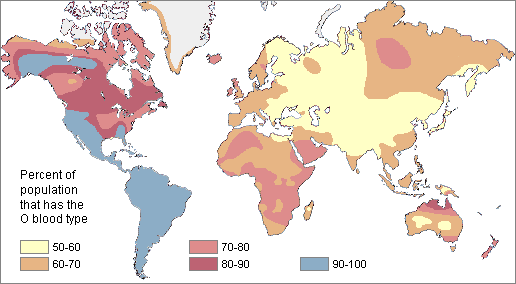
Figure TAH11. World distribution of Type 'O' blood. From [27].
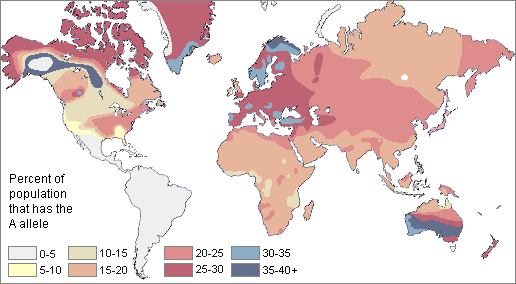
Figure TAH12. World distribution of Type 'A' blood. From [27].
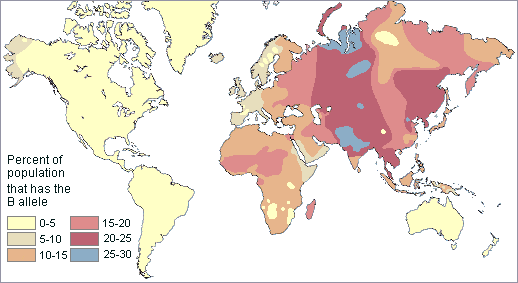
Figure TAH13. World distribution of Type 'B' blood. From [27].
Then look at the map for the 'B' factor. The distribution makes it obvious (?) that the 'B' factor arose in Western Asia. From there it passed on to parts of Europe and Africa, leaving the Americas and Australia largely untouched. We could say the the Homo "B-Blood" landrace is typically native to western Asia.
Finally, consider the map for 'O' blood. This is rather different to the other two, because it shows not a Factor, but the lack of a Factor. In a way, it is the complement of the other two. It clearly shows the migrations of Europeans and Asians to other parts of the world has been less influential where South America is concerned, and also Central America/ Mexico and low-population swathes of the American Arctic.
Another area where landraces can be distinguished among a general species population is in their resistance to disease, for example some barley populations showing complete or partial resistance to yellow rust and powdery mildew [28]. What happens is a particular local population becomes subjected to a negative (or sometimes positive) influence, such as influx of a disease-carrying insect. The landrace acts to counter or take advantage of the influence. This is just a small local example of evolution.
Now, Back Into the Past
Go back now to Figure TAH6, a conventional picture of how modern humans may have evolved from earlier hominids (close relatives of man). The general picture, one of evolution of modern man from more 'primitive' forms over about the last 5 million years, fits in well with the broader picture.
But notice that many of the earlier groups are given genus names other than Homo, that is, they are considered as too different to modern man as to be able to interbreed.
In the present article view, all these groups are considered just as landraces of Homo. Putting some of these landraces into a different species, or even a different genus, contradicts the definitions above in that individuals with common ancestors must be in the same species. To go over into different species or genera, the ability to interbreed must be lost, and there is no evidence that this happened.
The figure suggests that an earlier form of man, Homo heidelbergensis, evolved into two new species, Homo neanderthalensis and Homo sapiens. That would imply they were no longer able to interbreed. Look for a reason why this should have happened, and you may be at a loss. Read the chart as landraces, Homo "Heidelbergensis" drifting to Homo "Neanderthalensis" and Homo "Sapiens" in different parts of the world, still able to interbreed, and the picture is in better accord with reality.
The previous Observation suggested that all forms of man found in the modern world are only landraces of a single Homo genus. The current Observation extends this back to the human ancestors and close relatives of humans pictured over the last 5 million years.

Observation TAHO-3. Past Human Landraces.
One of the implications of this is that any landrace members of Homo over the last 5 million years could potentially breed. So if 2-million-year-old Homo "Erectus" sperm could be found preserved in an ancient glacier, in theory it could be used to fertilize a modern female.
New Discoveries, New Species
Over recent years, more and more discoveries of remains of early Man have been uncovered. At the same time, great advances have been made in the analysis of DNA from ancient humans. This used to be thought not possible.
The first of the 'new' discoveries of modern times was that of the 'Hobbit Man', Homo floresiensis, found in 2003 on the Indonesian island of Flores [32]. This discovery was a giant surprise, for many reasons. The Hobbit People were much smaller than most human species, only around 90-105 cm high, and with notably small brains, around 380 cu cm -- about the size of chimpanzee brains, and only a quarter of the size in modern humans.
Hobbit Man remains have been dated from about 95,000 years ago to as recently as 13,000 years ago, knocking the beginning of our own civilization.
Further research by an Australian-Indonesian team [29] showed many of the Hobbit bone and joint features were much more similar to those of ancient human species like Homo erectus, reckoned to have existed from about 1.8 million to 100,000 years ago, than to modern humans.
Local legends exist on Flores of a race of tiny people, and some of the present inhabitants are noticeably small in stature. All this fits in with the concept that the Homo "Hobbit" landrace is just another human landrace, perhaps adapted under small-island conditions to dwarf stature -- dwarfism is not uncommon in animal species confined to small islands.
The following figure gives a visual comparison of how some of the older and modern Homo landraces may have looked. Renderings from other artists and researchers may look a little different.
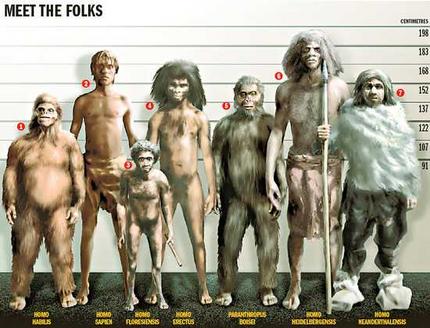
Figure TAH14. Artist's conceptions of human types. From [31].
Summary from [31]:
1. Homo habilis. Lived: 2.4 to 1.6 million years ago. Habitat: Tropical Africa. Diet: Omnivorous – nuts, seeds, tubers, fruits, some meat.
2. Homo sapiens. Lived: 200,000 years ago to present. Habitat: All. Diet:Omnivorous - meat, vegetables, tubers, nuts, pizza, sushi.
3. Homo floresiensis. Lived: 95,000 to 13,000 years ago. Habitat: Flores, Indonesia. Diet: Omnivorous - meat included pygmy stegodon, giant rat.
4. Homo erectus. Lived: 1.8 million years to 100,000 years ago. Habitat: Tropical to temperate - Africa, Asia, Europe. Diet: Omnivorous - meat, tubers, fruits, nuts.
5. Paranthropus boisei. Lived: 2.3 to 1.4 million years ago. Habitat: Tropical Africa. Diet: Omnivorous - nuts, seeds, leaves, tubers, fruits, maybe some meat.
6. Homo heidelbergensis. Lived: 700,000 to 300,000 years ago. Habitat: Temperate and tropical, Africa and Europe. Diet: Omnivorous - meat, vegetables, tubers, nuts.
7. Homo neanderthalensis. Lived: 250,000 to 30,000 years ago. Habitat: Europe and Western Asia. Diet: Relied heavily on meat, such as bison, deer and musk ox.
The next major discovery was of Denisova Man, found in 2010 in a cave in Siberia. Here's an extract from Wikipedia [33].
"Denisova hominins, or Denisovans, are Paleolithic-era members of a species of Homo or subspecies of Homo sapiens. In March 2010, scientists announced the discovery of a finger bone fragment of a juvenile female who lived about 41,000 years ago, found in the remote Denisova Cave in the Altai Mountains in Siberia, a cave which has also been inhabited by Neanderthals and modern humans.
Analysis of the mitochondrial DNA (mtDNA) of the finger bone showed it to be genetically distinct from the mtDNAs of Neanderthals and modern humans. Subsequent study of the nuclear genome from this specimen suggests that this group shares a common origin with Neanderthals, that they ranged from Siberia to Southeast Asia, and that they lived among and interbred with the ancestors of some present-day modern humans, with up to 6% of the DNA of Melanesians and Australian Aborigines deriving from Denisovans.
A comparison with the genome of a Neanderthal from the same cave revealed significant local interbreeding, with local Neanderthal DNA representing 17% of the Denisovan genome, while evidence was also detected of interbreeding with an as yet unidentified ancient human lineage. Similar analysis of a toe bone discovered in 2011 is underway, while analysis of DNA from two teeth found in different layers than the finger bone revealed an unexpected degree of mtDNA divergence among Denisovans."
Really, this is more of the same, with landrace "Denisova" obviously interbreeding with other human landraces. Notice that there is information on the ancestors of Melanesians and Australian Aborigines, and also that there were surprisingly big genetic variations between different individuals.
Finally, in late 2013, a new analysis was reported of five human skulls from Dmanisi, Georgia, dating from 1.8 million years ago. These skulls were all from the same excavation site, but showed wide variation, and were previously assigned to three different human species. Here's an extract from the article [35].
"One of the most complete early human skulls yet found suggests that what scientists thought were three hominin species may in fact be one.
This controversial claim comes from a comparison between the anatomical features of a 1.8-million-year-old fossil skull with those of four other skulls from the same excavation site at Dmanisi, Georgia. The wide variability in their features suggests that Homo habilis, Homo rudolfensis and Homo erectus, the species so far identified as existing worldwide in that era, might represent a single species."

Figure TAH15. The Dmanisi skulls. From [34].
Chromosomes -- Beyond Homo
OK, if all humans, modern and ancient, are only landraces of the genus Homo, and can potentially interbreed, what about interbreeding with close-to-human species such as chimpanzees?
There is a real underlying difference between humans and other great apes, to do with their chromosome numbers. Humans have 23 chromosome pairs, while all the others have 24 pairs.
This is not a case of a complete chromosome having been lost somewhere in the past, instead Chromosome 2 in humans exactly corresponds to two chromosomes in the other great apes, joined end to end.
Here's some of what Wikipedia says [36].
"All members of Hominidae except humans, Neanderthals, and Denisovans have 24 pairs of chromosomes. Humans have only 23 pairs of chromosomes. Human chromosome 2 is widely accepted to be a result of an end-to-end fusion of two ancestral chromosomes."
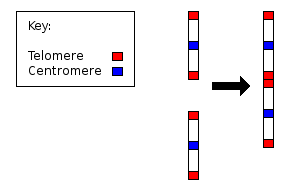
Figure TAH16. Fusion of ancestral chromosomes left distinctive remnants of telomeres, and a vestigial centromere. From [36].
This 'Chromosome-2 Event' must have occurred at the beginning of the human story, some 5 million years ago, leading to a clear physical distinction between humans and apes. This might have been a mutation affecting a single individual, or more likely a group or groups of 'pre-humans'. At any event, the Event must have involved local individuals who interbred.
In my view, the note above that Neanderthals and Denisovans did not have 23 chromosome pairs will prove to be an error. It's an understandable error, since workers with ancient human DNA have to work with chromosome fragments, and fragments of human Chromosome-2 would look just like the two un-merged ape fragments.
Hybrids of Humans and Apes
No substantiated records of human-ape hybrids are known. The chromosome count difference makes it not impossible, but extremely unlikely. On the other hand, hybrids between the two species of chimpanzee, which do have similar chromosome sets, are known.
That is not to say that hybrids between creatures with different chromosome numbers are completely impossible. There are well-substantiated records of hybrids between sheep and goats, for example.Here is some of what Wikipedia has to say on this [37].
"A sheep–goat hybrid is the hybrid offspring of a sheep and a goat. Although sheep and goats seem similar and can be mated, they belong to different genera in the subfamily Caprinae of the family Bovidae. Sheep belong to the genus Ovis and have 54 chromosomes, while goats belong to the genus Capra and have 60 chromosomes. The offspring of a sheep-goat pairing is generally stillborn. Despite widespread shared pasturing of goats and sheep, hybrids are poorly attested, indicating the genetic distance between the two species.
At the Botswana Ministry of Agriculture in 2000, a male sheep impregnated a female goat resulting in a live offspring. This hybrid had 57 chromosomes, intermediate between sheep (54) and goats (60) and was intermediate between the two parent species in type. It had a coarse outer coat, a woolly inner coat, long goat-like legs and a heavy sheep-like body. Although infertile, the hybrid had a very active libido, mounting both ewes and does even when they were not in heat."
Although many hybrids are reckoned to be infertile, it some cases it might just be that no partner is available. With the above male sheep-goat hybrid, with 57 chromosomes, it is possible that viable offspring could have been produced if female 57-chromosome hybrids were available. Something similar must have happened at the human Chromosome-2 event to give rise to the initial Homo breeding population.
Answering The Questions
We now have enough information to be able to answer the list of questions posed at the beginning. Here goes.
Q1. Did modern man evolve in Africa, and spread from there into all regions of the Earth?
A1. No.
The idea that modern Man evolved in Africa, and spread from there into the rest of the world, has achieved amazing acceptance with the public and with anthropologists. Amazing, because the concept virtually lacks any evidence to support it, and it's even puzzling to see why it should have been put forward in the first place.
The reasoning, such as it is, seems to have been that some important early human-linked fossils were first discovered in Africa, in the Rift Valley. From here there has been a giant leap to conclude that 'modern man' also 'came' from Africa.
Looked at from the outside, the concept is close to absurd. We have these landraces of dark-skinned, black-haired African people with mostly kinky hair. Then some of them abruptly leave Africa for the rest of the world, where they change into landraces of blond Scandinavians, sallow-skinned Chinese, and red-haired Scots and Russians with white skins. Meanwhile, those back in Africa remain as they were.
This concept goes against all logic, and moreover has no evidence from such things as the blood-group distributions shown above. What's more, the detail in the claims of some out-of-Africa supporters is breathtaking.
Here is one such assertion from Nicholas Wade (p. 75 in [38]).
"The epic ... crossing of the first modern humans into the world beyond Africa cannot be reconstructed in ... detail. Still, some essential features of this ancient exodus are clear enough. The first, based on genetic analysis, is that there seems to have been just a single emigration of modern humans from Africa. A second genetic inference is that the number of those who left was probably quite small .. as few as some 150 people ..." .
Wade's estimate of the date of this exodus is about 50,000 years ago. Readers will be left to judge how well Wade's picture compares with the present one of a continually mingling and developing matrix of landraces, encompassing the whole world population.
Q2. Did the cleverer humans from Africa wipe out or outbreed the Neanderthals who occupied Europe?
A2. No.
The present reasoning makes it clear that the Neanderthal landrace, like other landraces, was just a convenient grouping of its era, and mixed and matched with other landraces a it went on.
But the concept of comparative intelligence and brain size as a competitive criterion is worth an aside. There is a natural assumption that bigger brains mean more intelligence, and an evolutionary advantage. This assumption is unfounded.
Human brains weigh about 1.4 kg. Here are some comparisons from [39].
"The North American ruby-throated hummingbird has a brain weighing less than a gram, whereas a blue whale has a 6 kg brain. Yet both show a marvellous variety of behaviours. Both sing, defend territories, attract mates, raise young and migrate seasonally for long distances. The tiny-brained hummingbird also has an elaborate courtship dance, builds nests and solves some interesting pattern-recognition problems in finding flowers."
Nor does brain size necessarily correlate with intelligence. An African Grey Parrot called Alfred was probably the most intelligent bird known [40]. According to Nature, Alex could accurately add together arabic numerals to a sum of eight, understood the concept of zero, had a vocabulary of over 100 English words, and was judged to have the intelligence of a 5-year-old child. Alex had a brain the size of a walnut, weighing maybe 30 gm.
So when we look back at the sizes of early and modern human brains, it seems that size alone does not determine intelligence. Sizeists were rather disconcerted by the fact that average brain size for the shambling, cave-dwelling Neanderthals was greater than that for modern man. On the other hand, the "Hobbit" landrace, with brains a quarter the size of you and me, was obviously able to forage, hunt and cook, probably better than some of us.
It appears that what's important is how well specific brain functions operate. The Wikipedia article on Floresiensis [32] mentions this as follows.
"An indicator of intelligence is the size of Brodmann's area 10, the dorsomedial prefrontal cortex, an area of the brain associated with higher cognition. LB1's region 10 is about the same size as that of modern humans, despite the much smaller overall size of the brain."
Q3. Will 'Missing Link' fossils, showing how modern man evolved from earlier species such as Homo erectus, ever be found?
A3. No.
In the present view, all human evolution took place, and is taking place, in a swirl of interlinked landraces. So individual key 'missing-link' individuals never existed.
Q4. From whom did the third human species, the Homo floresiensis "Hobbit Man" who lived in South-East Asia till some 18,000 years ago, descend?
A4. No one specific landrace.
In the present view, the Hobbit landrace evolved from preceding local landraces, Homo "Erectus" and others. The general supposition that this landrace attained its small stature through small-island dwarfism pressures seems very reasonable. However, there is nothing to suggest that their smaller average brain size disadvantaged them compared to other landraces.
Q5. How many species of humans have ever existed?
A5. Take your pick.
There are an infinite number of ways of dividing all the humans who ever existed into different landraces, according to this or that criterion. On the logical premise, the answer is Only One.
Q6. Are humans with bigger brains cleverer than those with small?
A6. No.
This matter is dealt with in A2 above.
Q7. Are some races of Man inherently more intelligent than others?
A7. Surprisingly, Yes.
In 2005, Gregory Cochran and colleagues reported [41] on a study of intelligence in Ashkenazi Jews. They concluded that this landrace had an average IQ of 115, the highest average IQ of any ethnic group for which reliable data exist.
Their work has been summarized by Nicholas Wade (p. 255 in [38]). He comments as follows.
"The origin of the Ashkenazi Jews is obscure but they were established in northern France by shortly after AD 900. Most had become moneylenders by AD 1100 ... moneylending was an intellectually demanding profession, not least because the Indian numerals in use today, and specifically the concept of zero, did not become widespread in Europe until around 1500. Figuring out xvii percent of cccl, without the use of zero, is not a straightforward computation.
From roughly 800 AD to 1650 or 1700 AD, the great majority of the Ashkenazi Jews had managerial and financial jobs, jobs of high complexity, and were neither farmers nor craftsmen. In this they differ from all other settled people of which we have knowledge.
The proportion of northern Europeans with IQs greater than 140 is 4 per thousand but the figure for Ashkenazim is 23 per thousand, a sixfold difference. ... Ashkenazim make up only 3% of the U.S. population but have won 27% of U.S. Nobel prizes ... and account for more than half of world chess champions."
This finding may offend politically correct, "All men are created equal" types, but it is actually quite reasonable. No one is surprised when pressures on the "Kalahari Bushmen" landrace has created people with exceptional skills in running down animals and finding water in a generally arid environment. With another identifiable landrace subjected to intellectual pressures, the emergence of higher average intelligence is only to be expected.
So where are we?
Here then is a view of human evolution and history which has moved from attention to changes in specific areas and in specific individuals, to one where the whole matrix of human population, now and in the past, is seen as a single entity. Certainly, dramatic changes have occurred in particular parts in particular eras, but these are only parts of a complex whole.
* * * * * * * * * * * * * * * * * * * * *

References and Links
1. Tree Talk. http://arborsculpture.blogspot.com.au/ .
2. David Noel. Great Fallacies of Science and Society. http://www.aoi.com.au/acceptology/Fallacies/index.htm .
3. The Arguable Quotations Website. http://www.aoi.com.au/arguable/ .
4. The Placid Universe Model -- Why the Universe is NOT Expanding, or, The real origin of CMBR, Cosmic Microwave Background Radiation. http://www.aoi.com.au/bcw/Placid/index.htm .
5. The Ancestor Paradox. http://www.genetic-genealogy.co.uk/supp/ancestor_paradox.html .
6. World population estimates. http://en.wikipedia.org/wiki/World_population_estimates .
7. Comedian Alexander Armstrong is descended from William the Conqueror. http://www.express.co.uk/news/weird/194687/Comedian-Alexander-Armstrong-is-descended-from-William-the-Conqueror .
8. Genealogical Trees. http://tudorhistory.org/trees/bigtree.jpg .
9. Hominization: On the Origin of Mankind. http://www.philvaz.com/apologetics/p83.htm .
10. Human evolution. http://en.wikipedia.org/wiki/Human_evolution .
11. How Many People Have Ever Lived on Earth? http://www.prb.org/Publications/Articles/2002/HowManyPeopleHaveEverLivedonEarth.aspx .
12. Make Rope Out Of Dead Plants. http://2.bp.blogspot.com/-edeFWWLYF-g/TxF6mvE_2LI/AAAAAAAABow/HVtjZAZVLqc/s1600/Make-rope-out-of-dead-plants-with-no-tools.jpg .
13. Polymer climbing rope. http://www.jeffreythompson.org/blog/wp-content/uploads/2012/08/Micro-CTofPolymerClimbingRope-2-web.png .
14. How to Identify Oak Leaves. http://pad3.whstatic.com/images/thumb/1/10/Identify-Oak-Leaves-Step-1.jpg/670px-Identify-Oak-Leaves-Step-1.jpg .
15. D.J. Mabberley. The Plant-Book. 2nd ed. Cambridge University Press, 1997.
16. Species. http://en.wikipedia.org/wiki/Species .
17. Discovering a ring species. http://evolution.berkeley.edu/evolibrary/article/0_0_0/devitt_02 .
18. The Cabbages of Doom. http://cabbagesofdoom.blogspot.com.au/2012/11/artificial-selection-versus-natural.html .
19. Dennis McCarthy. Here Be Dragons. Oxford University Press, 2011.
20. Ensatina. http://en.wikipedia.org/wiki/Ensatina .
21. Understanding Evolution. http://evolution.berkeley.edu/evolibrary/images/interviews/ranges_map.jpg
22. Many Dog Sizes To Suit Your Lifestyle. http://www.choosing-a-dog-made-easy.com/dog-sizes.html .
23. An Overview of Rosa Fortuniana Root Stock. http://www.roses4az-mevrs.org/downloads/Articles/fortunianaRootstock/An%20Overview%20of%20Fortuniana.pdf .
24. Dolly Parton. http://www.treloarroses.com.au/products/product.asp?pID=2368 .
25. David Noel. How the Neanderthals became the Basques. http://www.aoi.com.au/bcw/neanderbasque.htm .
26. Landrace. http://en.wikipedia.org/wiki/Landrace .
27. Human Blood: An Introduction to Its Components and Types. http://anthro.palomar.edu/blood/default.htm .
28. J. A. G. van Leur et al. Diversity for Disease Resistance in Barley Landraces from Syria and Jordan. http://onlinelibrary.wiley.com/doi/10.1111/j.1439-0523.1989.tb00393.x/abstract .
29. Homo floresiensis. http://australianmuseum.net.au/Homo-floresiensis .
30. Ewen Callaway. Mystery humans spiced up ancients’ rampant sex lives. Nature/ 2013 Nov 19.
31. Meet The Folks. http://31.media.tumblr.com/tumblr_lkg5geJMhG1qagynuo1_500.jpg .
32. Homo floresiensis. http://en.wikipedia.org/wiki/Homo_floresiensis .
33. Denisova hominin. http://en.wikipedia.org/wiki/Denisova_hominin .
34. Sid Perkins. Skull suggests three early human species were one. Nature/ 2013 Oct 17.
35. Tabitha M. Powledge. Human Evolution at Dmanisi. http://blogs.plos.org/onscienceblogs/files/2013/10/Dmanisi-skulls.jpg
36. Chromosome 2 (human). http://en.wikipedia.org/wiki/Chromosome_2_(human) .
37. Sheep–goat hybrid. http://en.wikipedia.org/wiki/Sheep–goat_hybrid .
38. Nicholas Wade. Before The Dawn -- Recovering the lost history of our ancestors. Penguin Books, 2007.
39. Your Amazing Brain... . http://www.youramazingbrain.org/insidebrain/brainevolution.htm .
40. Alex the parrot’s last experiment shows his mathematical genius. http://blogs.nature.com/news/2012/02/alex-the-parrots-last-experiment-shows-his-mathematical-genius.html? .
41. Gregory Cochran et al. Natural History of Ashkenazi Intelligence. Journal of Biosocial Science, 2005.
Stablemate articles:
How the Neanderthals became the Basques
At: www.aoi.com.au/bcw/neanderbasque.htm .
Go to the BCW Home Page
Draft Versions, 1.0-1.2, 2013 Nov 1-5. V 1.3, 2013 Nov 12.
v.1.4,1.5, 2012 Nov 18-21. v.1.6, first up on Web, 2013 Nov 22. v.1.7, 2013 Nov 25, Dec 5.
V. 1.71, technical adjustments, 2014 Jun 21.




![You don't get a Nobel Prize for pointing out the obvious, even though it wasn't obvious before you pointed it out. [3]](NobelText.png)


















